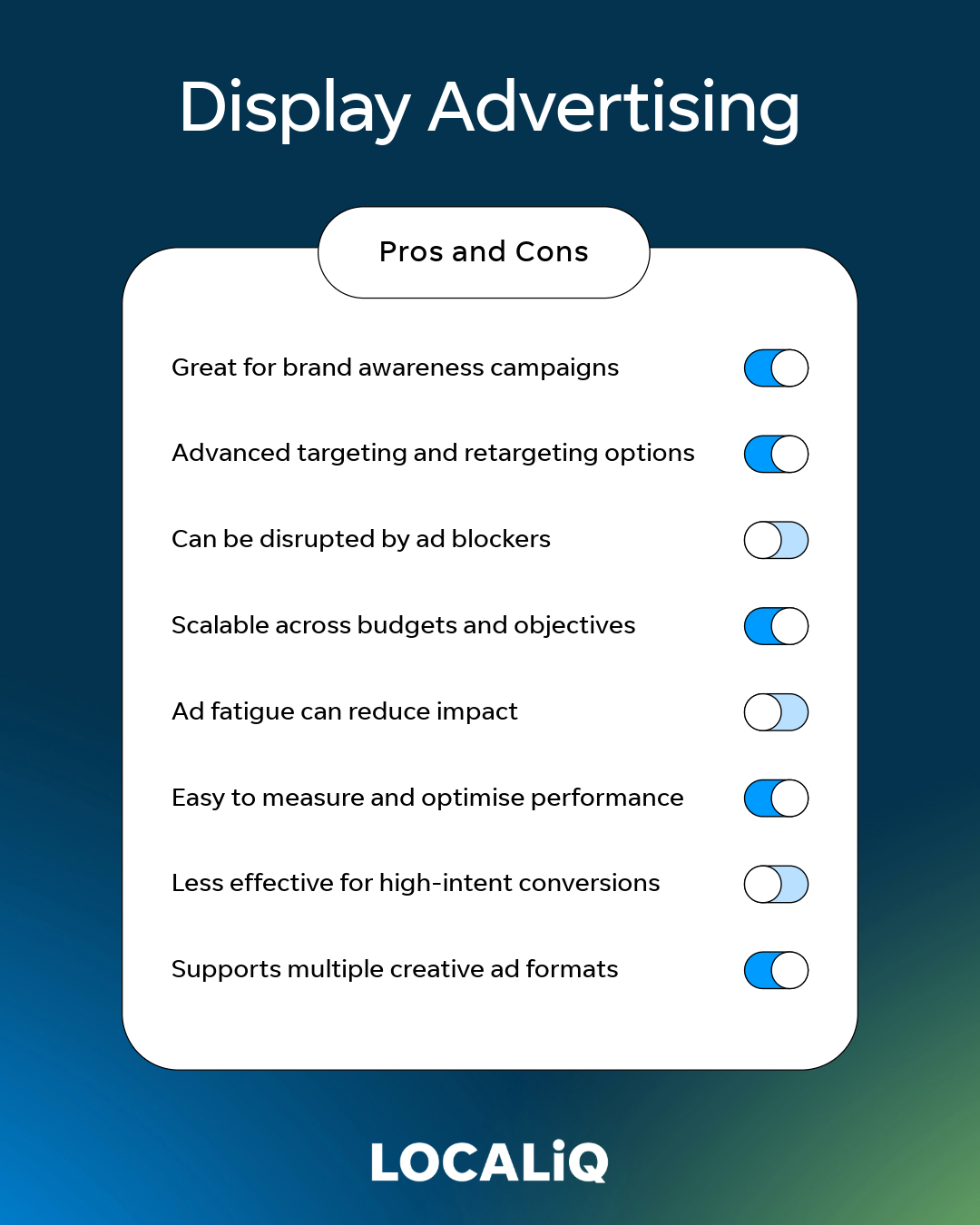- What is display advertising?
- How does display advertising work?
- What are the different types of display advertising?
- What are the benefits of display advertising?
- Display advertising best practices
- How to get started with display advertising
What Is Display Advertising?
Display advertising refers to visual-based ads (such as banners, images, or videos) that appear across websites, apps, and social media platforms. Unlike search ads, which rely on text, display ads capture attention through engaging visuals. Display ads are available in a variety of sizes and placements, which can help combat ad fatigue.
Display ads can appear across a wide range of third-party websites, including news outlets, blogs and forums. This allows your business to reach an entirely new audience beyond your existing channels. You can also target users based on interests, demographics, or online behaviour.
They are commonly served through advertising networks such as the Google Display Network (GDN), which gives advertisers access to millions of websites, apps, and Google-owned properties like YouTube and Gmail. Other platforms, like Microsoft Audience Network, programmatic DSPs (Demand-Side Platforms), and social display networks, also offer wide-reaching display ad placements.
At LOCALiQ, we’re in a unique position to offer placements across a network of 200+ Newsquest’s local publication websites, providing businesses with an opportunity to target a local, online audience.
How does display advertising work?
Without getting too technical, display ads are typically served through automated systems using programmatic advertising. These systems use real-time data to determine when and where your ad should appear based on user behaviour, demographics, and interests.
These adverts will link back to a landing page on your website. It is best to link to a web page that is related to the content of your advert, rather than just your top-level website address. For instance, if you are promoting a “50% off sale”, then the landing page should be related to the sale.
Main components of display advertising:
- Ad creatives: The visual elements shown to users.
- Targeting options: Audience selection based on demographics, location, interests, etc.
- Bidding strategy: How much you’re willing to pay for clicks or impressions.
What are the different types of display advertising?
As mentioned previously, there are multiple display ad sizes and formats. We’ve got a blog that explains each of the different types of display ads in detail, but here’s an overview:
Banner ads
Banner ads are a traditional type of display advertising. They come in various sizes and formats and are typically placed in prominent positions like the top, bottom, or sides of web pages.
Video ads
Video ads offer dynamic content that can be more engaging than static formats. They appear across multiple platforms and can be skippable or non-skippable.
Interstitial ads
Interstitial ads are full-screen ads that appear at natural transition points within apps or websites, such as between activities or during page loads. They often require user interaction to dismiss and are commonly used in mobile applications. While they can be highly engaging, they can disrupt user experience.
Pop-up ads
Pop-up ads are windows that appear over the main content, often triggered by specific user actions like entering or exiting a site. Despite mixed opinions, they remain effective when used sparingly and with compelling offers.
Rich media ads
Rich media ads incorporate interactive elements like video, audio, and clickable features, providing a more engaging experience than traditional static ads.
Native ads
Native ads are designed to match the look and feel of the platform on which they appear, blending seamlessly with the surrounding content. They often appear as sponsored articles or recommended content and are effective for delivering messages in a non-disruptive manner.
What are the benefits of display advertising for businesses?
Display ads offer several advantages for businesses, and they can be great to use to complement existing marketing strategies. Let’s take a look at some of the key benefits.
Display ads can help boost brand awareness
Display ads give your brand the chance to be seen repeatedly by the same users. Even if someone doesn’t click your ad right away, consistent exposure helps build recognition and trust. Over time, that familiarity increases the chances they’ll remember your business when they need your products or services.
Display ads can help you reach a wider audience
A common challenge for smaller businesses is expanding beyond their existing online audience.
With the right type of display ads, your business can appear across hundreds (even thousands) of websites and apps, getting your brand in front of new people who may not have discovered you otherwise.
Display ads allow for retargeting
With the decline of third-party cookies and the introduction of stricter data privacy laws, retargeting looks different to how it did a couple of years ago, but reaching people who have previously expressed interest in your brand is still possible.
By utilising first-party data (information collected directly from users with clear consent). Platforms like Google and Meta continue to support retargeting within their own ecosystems using logged-in user data.
To run effective retargeting campaigns today, businesses need to prioritise transparency, consent, and secure data practices. Tools like server-side tracking and customer data platforms (CDPs) can help manage this more responsibly.
Flexible placements & budgeting
One of the biggest benefits of Display Advertising is how versatile it can be when it comes to fitting in with your overall marketing strategy.
Display ads can appear across a wide range of websites, apps, and even YouTube videos, allowing you to tailor your placements based on your target audience’s interests and behaviours. Whether you’re aiming for high-traffic news sites or niche blogs, you can choose where your ads are seen.
Budgeting is just as flexible. You can start with a small daily spend, set limits to control costs, and scale up as you see results. This makes display advertising accessible for businesses of all sizes — from small local companies to national brands looking to boost visibility.

What are some best practices for effective display advertising?
Now you’ve got an understanding of display ads and their benefits, here are a few tips to ensure you get the most out of your display advertising campaign:
Use eye-catching visuals
If you want people to notice your ad, then it needs to stand out, especially when competing for attention across a busy web page. Use high-quality imagery, engaging messaging and a clean design. Bold colours can help capture attention too, but make sure they’re in keeping with your branding. Remember: an ad that is too busy, or has too many clashing colours, can look unprofessional and may lead to users not trusting your business.
Create compelling CTAs (Call-to-Actions)
Your ad should include a clear call to action. Whether it’s “Shop Now,” “Learn More,” or “Get a Free Quote,” your CTA should guide the viewer on what to do next. Make it prominent, punchy, and benefit-focused.
As mentioned previously in this article, make sure that when the user clicks the advert, they are taken to a page that reflects the advert.
For instance, if your advert says “Get a Free Quote” then the landing page should have a form, or clear instructions on how the user can get the free quote.
Target specific audiences
One of the biggest strengths of display advertising is precision targeting. Take advantage of audience targeting options like interests, demographics, behaviours, or retargeting past website visitors. The more relevant your ad is to the viewer, the better it will perform.
A/B test your creatives
Don’t rely on guesswork, be sure to test out different versions of your ads.
From headline and imagery to CTA button colours, running variations of your adverts at the same time will help you understand what resonates best with your audience. Even small tweaks can lead to significant improvements in click-through rates and conversions.
Optimise for mobile devices
With a large portion of users browsing on mobile, it’s essential that your ads look great and load quickly on smaller screens. Use responsive ad formats where possible, and keep your text short and snappy for easy readability.
Use frequency capping to avoid overexposure
Frequency capping is a setting in display advertising that limits the number of times your ad is shown to the same person within a specific time frame. For example, no more than 3 impressions per user per day.
While repeated exposure can help build brand recognition, seeing the same ad too many times can be annoying and counterproductive. Use frequency capping to limit how often your ads are shown to the same person within a given time frame.
Frequency capping also allows you to preserve your ad budget, ensuring you’re not wasting spend on people who’ve already seen your ad multiple times and aren’t engaging.
How to get started with display advertising:
If you;’re interested in utilising display advertising to promote your business, here’s a step-by-step guide to launching a successful campaign.
1. Define your campaign goals
Before you dive into ad creation or targeting, you need to be crystal clear on what success looks like. Do you want to:
- Build brand awareness?
- Drive traffic to your website?
- Generate leads or conversions?
Your goal will determine everything else, from the ad format you choose to how success is measured.
2. Choose your ad platform
Display ads can run across a wide variety of platforms, including:
- Google Display Network (GDN): Reach users across millions of websites and apps.
- Microsoft Advertising Network: Serve ads across properties like MSN, Outlook, and Microsoft Edge, as well as trusted partner sites. Particularly valuable for reaching a professional, B2B audience
- Programmatic DSPs: Use automated buying to place ads across premium sites and niche industry platforms.
Each platform has its own strengths, selecting the right one depends on your audience, budget, and campaign objectives.
3. Design your creatives
This is where your campaign comes to life visually. As mentioned earlier, your ads should include:
- Strong, clear messaging
- Eye-catching visuals
- A compelling call-to-action (CTA)
You’ll need different sizes and formats to suit multiple placements, and don’t forget to ensure your designs are mobile-friendly.
4. Set your targeting and budget
Now it’s time to decide who sees your ads (and how much you’re willing to spend!).
Targeting options may include:
- Demographics (age, location, job title)
- Interests and behaviours
- Remarketing to previous website visitors
- Contextual targeting (ads appear next to relevant content)
Budgeting can be daily or campaign-based, and should align with your expected reach and goals. Be sure to avoid common pitfalls such as overly broad targeting or inefficient spend.
5. Launch and monitor performance
At this stage you’ll have everything you need to press “go”, but this is only the start of your campaign. Once your campaign is live, you should start monitoring its performance. Here are a few key metrics to track:
- Impressions and reach
- Click-through rates (CTR)
- Conversions and cost-per-acquisition (CPA)
6. Optimise regularly based on data
The real power of display advertising lies in continuous improvement. A/B test different creatives, adjust your targeting, and tweak your messaging based on real-time performance data. At LOCALiQ we do this every day. We’re experts in spotting trends, running experiments, and adjusting campaigns for maximum ROI. Want to learn more? Visit our display advertising services page.
Wrapping Up
You should now have a solid understanding of what display advertising is and how it can benefit your business. If you’re looking for some help with running an effective display advertising campaign, get in touch. We’re an award-winning marketing agency with years of experience creating campaigns that drive real results.





